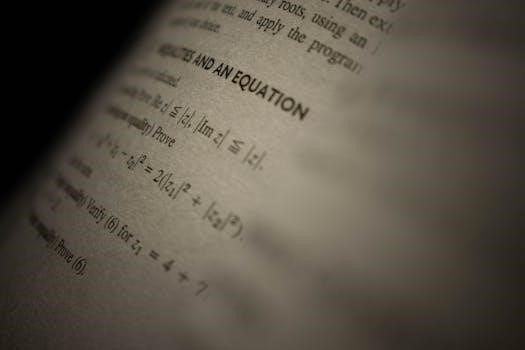Calculus⁚ Concepts and Contexts‚ 4th Edition PDF
Stewart’s Calculus⁚ Concepts and Contexts‚ Fourth Edition‚ offers a streamlined approach‚ focusing on major concepts. It supports these with precise definitions‚ explanations‚ and carefully graded problems‚ fostering a deeper conceptual grasp crucial for STEM success.
Overview of the Textbook
Stewart’s “Calculus⁚ Concepts and Contexts‚ 4th Edition” presents a streamlined approach to learning calculus‚ emphasizing core ideas. The textbook supports these concepts with precise definitions‚ patient explanations‚ and a carefully graded problem set. This edition aims to foster a deeper conceptual understanding rather than rote memorization‚ crucial for success in STEM fields.
The book covers a wide range of topics‚ including functions‚ limits‚ derivatives‚ integrals‚ and differential equations. It also explores infinite sequences and series‚ vectors‚ and vector calculus. The textbook’s design incorporates real-world applications‚ demonstrating the relevance of calculus in various contexts. This approach encourages active learning and conceptual understanding‚ moving away from a purely procedural focus.
Furthermore‚ the availability of supplementary materials like solution manuals and online resources enhances the learning experience. These resources provide additional support for students as they navigate the challenges of calculus.
Key Concepts Covered in the Textbook
“Calculus⁚ Concepts and Contexts‚ 4th Edition” delves into fundamental calculus concepts‚ starting with a thorough exploration of functions and models. It establishes a strong foundation before moving into the core ideas of limits and derivatives. The text meticulously covers differentiation rules‚ equipping students with essential tools for problem-solving.
Applications of differentiation are extensively discussed‚ including optimization problems and related rates‚ showcasing the practical utility of calculus. The book then transitions to integrals‚ covering both definite integrals and their diverse applications. Integration techniques are presented clearly‚ enabling students to tackle complex problems.
Furthermore‚ the textbook explores differential equations‚ infinite sequences and series‚ vectors‚ and vector calculus. These advanced topics provide a comprehensive understanding of calculus and its extensions. The emphasis throughout is on conceptual understanding‚ supported by precise definitions‚ detailed explanations‚ and carefully graded problems designed to solidify learning and promote analytical thinking.

Functions and Models
This section introduces functions as fundamental building blocks in calculus. It explores various function types and their representations. Mathematical models are presented‚ demonstrating how functions describe real-world phenomena‚ emphasizing their practical applications.
Functions form the bedrock of calculus‚ serving as essential tools for describing relationships between variables. This section explores the fundamental definition of a function‚ emphasizing its role as a mapping from a set of inputs to a set of outputs. We examine different ways to represent functions‚ including algebraic formulas‚ graphs‚ and tables of values.
Various types of functions are introduced‚ such as linear‚ quadratic‚ polynomial‚ trigonometric‚ exponential‚ and logarithmic functions. Each type is analyzed for its unique properties and characteristics. The section covers function notation‚ domain‚ range‚ and how to evaluate functions for specific input values.
Transformations of functions‚ including shifts‚ stretches‚ and reflections‚ are also discussed‚ providing a comprehensive foundation for understanding more complex calculus concepts. Understanding functions is crucial for success in calculus.
Mathematical Models
Mathematical models are crucial for translating real-world phenomena into mathematical language‚ enabling analysis and prediction. This section introduces the concept of a mathematical model as a representation of a system or relationship using mathematical concepts and language. We explore the process of creating mathematical models‚ emphasizing the importance of identifying key variables and relationships.
Various types of mathematical models are examined‚ including linear‚ exponential‚ and periodic models‚ each suited for different scenarios. The section covers how to fit models to data using techniques like regression analysis‚ and how to interpret the results to gain insights into the underlying phenomena.
The limitations and assumptions of mathematical models are also discussed‚ highlighting the importance of validating models against real-world observations. Examples from physics‚ engineering‚ and economics are used to illustrate the application of mathematical models in solving practical problems. Understanding mathematical models is essential for applying calculus to real-world situations.

Limits and Derivatives
This section delves into the foundational concepts of limits and derivatives. Understanding limits is crucial for defining continuity and derivatives. We’ll explore differentiation rules and their applications in various contexts‚ emphasizing their role in calculus.
The Concept of a Limit
The concept of a limit forms the bedrock of calculus‚ providing a way to analyze the behavior of functions as they approach specific values. It allows us to understand what happens to a function’s output when its input gets arbitrarily close to a certain point‚ without necessarily reaching that point. This is essential for defining continuity and derivatives.
Limits are not about what happens at a specific point‚ but rather what happens near it. This subtle distinction is crucial. The formal definition of a limit‚ often referred to as the epsilon-delta definition‚ provides a rigorous way to express this idea.
Understanding limits is fundamental for grasping more advanced calculus concepts; They allow us to deal with indeterminate forms and define instantaneous rates of change‚ paving the way for derivatives and integrals. Exploring limits through graphical‚ numerical‚ and algebraic methods provides a comprehensive understanding.
Differentiation Rules
Differentiation rules are essential tools for finding derivatives of various functions efficiently. These rules provide shortcuts‚ eliminating the need to rely solely on the limit definition of the derivative. Mastering these rules is crucial for applying calculus in diverse fields. The power rule is fundamental for differentiating polynomial functions.
The constant multiple rule‚ sum rule‚ and difference rule allow us to differentiate more complex expressions by breaking them down into simpler terms. The product rule and quotient rule handle the differentiation of products and quotients of functions‚ respectively. The chain rule is vital for differentiating composite functions.
Trigonometric functions‚ exponential functions‚ and logarithmic functions also have specific differentiation rules. Understanding and applying these rules accurately is paramount for solving a wide range of calculus problems. Proficiency in differentiation rules enables efficient computation of derivatives and facilitates the analysis of function behavior.

Applications of Differentiation
Differentiation finds extensive applications in optimization‚ related rates‚ curve sketching‚ and physics. These applications demonstrate the power of calculus in solving real-world problems and understanding rates of change and optimization scenarios.
Optimization Problems
Optimization problems involve finding the maximum or minimum value of a function‚ subject to certain constraints. These problems often arise in various fields‚ such as engineering‚ economics‚ and physics‚ where it is essential to maximize efficiency or minimize costs.
Calculus provides powerful tools for solving optimization problems. The key idea is to use derivatives to find critical points‚ where the function’s rate of change is zero or undefined. These critical points are potential locations of maxima or minima.
To solve an optimization problem‚ one typically follows these steps⁚ first‚ identify the objective function to be optimized and the constraints. Then‚ express the objective function in terms of a single variable‚ using the constraints. Next‚ find the critical points by setting the derivative equal to zero and solving for the variable. Finally‚ use the first or second derivative test to determine whether each critical point corresponds to a maximum‚ minimum‚ or neither. The endpoint values should also be checked.
Related Rates
Related rates problems involve finding the rate of change of one quantity in terms of the rate of change of another quantity. These problems often arise when two or more quantities are related by an equation‚ and their rates of change are also related.
Calculus provides a framework for solving related rates problems. The key idea is to use implicit differentiation to differentiate the equation relating the quantities with respect to time. This yields an equation that relates the rates of change.
To solve a related rates problem‚ one typically follows these steps⁚ first‚ identify the quantities that are changing and their rates of change. Then‚ find an equation that relates the quantities. Next‚ differentiate both sides of the equation with respect to time‚ using the chain rule. Finally‚ substitute the known rates of change and solve for the unknown rate of change. Diagrams can often be helpful.

Integrals
Integrals represent the accumulation of quantities. They are fundamental to calculus‚ serving as the inverse operation to differentiation. This section explores definite integrals and their applications in various mathematical and real-world contexts.
The Definite Integral
The definite integral is a core concept‚ representing the net signed area between a curve and the x-axis over a specified interval. It’s formally defined as the limit of a Riemann sum‚ providing a rigorous way to calculate areas of irregular shapes. This powerful tool has wide-ranging applications in various fields.
Understanding the definite integral involves mastering techniques such as the Fundamental Theorem of Calculus‚ which connects differentiation and integration. Evaluating definite integrals often requires finding antiderivatives and applying the limits of integration. This process is essential for solving problems involving accumulated change.
Applications of the definite integral extend to calculating volumes‚ work done by a force‚ average values of functions‚ and probabilities. Its versatility makes it indispensable for modeling and analyzing real-world phenomena in physics‚ engineering‚ economics‚ and statistics. Mastering the definite integral is crucial for advanced calculus studies.
Applications of Integration
Integration transcends pure mathematics‚ finding extensive applications in diverse fields. It’s pivotal in physics for calculating work done by a variable force and determining the center of mass of objects. In engineering‚ integration helps compute volumes of solids‚ crucial for structural design and fluid dynamics. Economics utilizes integration to find consumer surplus and analyze growth models.
Moreover‚ integration is indispensable in probability and statistics. It allows the calculation of probabilities associated with continuous random variables and the determination of expected values. Biology employs integration to model population growth and analyze drug concentrations in the body. The versatility of integration makes it an essential tool for solving real-world problems.
Advanced applications include solving differential equations‚ calculating surface areas‚ and determining arc lengths of curves. Mastery of integration techniques‚ such as substitution‚ integration by parts‚ and trigonometric substitution‚ is vital for tackling these complex problems. These applications underscore the importance of integration in scientific and technological advancements.
